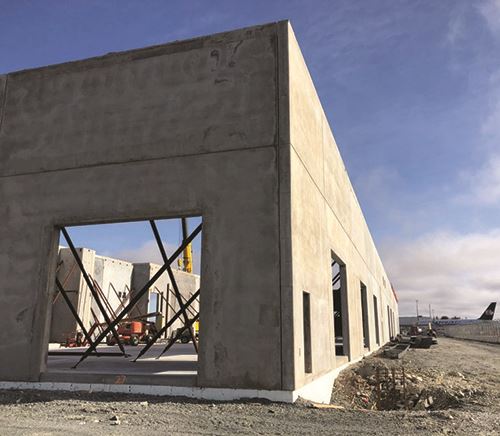As airports around the globe are seeing an uptick in passenger traffic, Halifax Stanfield International (YHZ) is experiencing incredible growth in cargo operations. Despite the COVID-19 pandemic, officials at the Nova Scotia airfield believed in the old maxim, “If you build it, they will come.” And they were right.
As airports around the globe are seeing an uptick in passenger traffic, Halifax Stanfield International (YHZ) is experiencing incredible growth in cargo operations. Despite the COVID-19 pandemic, officials at the Nova Scotia airfield believed in the old maxim, “If you build it, they will come.” And they were right.
 This year, with its new $36 million Air Cargo Logistics Park nearly complete, YHZ processed 25,000 metric tonnes of cargo from January through August—up from 22,400 metric tonnes over the same period in 2020.
This year, with its new $36 million Air Cargo Logistics Park nearly complete, YHZ processed 25,000 metric tonnes of cargo from January through August—up from 22,400 metric tonnes over the same period in 2020.
“The growth and demand we were seeing prompted us to move forward with this important investment,” explains Glen Boone, director of cargo and real estate development at Halifax International Airport Authority. “We knew we needed to act when we saw that our partners didn’t have the ability to get cargo to market quickly when multiple aircraft were on the ground.”
|
Project: Air Cargo Logistics Park Location: Halifax (NS) Stanfield Int’l Airport Cost: $36 million Funding: $18 million from federal government; $13 million from airport; $5 million from Nova Scotia provincial government Main Facilities: 62,000 sq. ft. Notable Feature: Cold chain space/capabilities for time-sensitive exports such as live lobster & fresh seafood Related Projects: New apron; aircraft deicing facility; truck docks; access roads; airside & groundside operational areas Tenants: First Catch Fisheries; Cargojet Construction: Fall 2019-fall 2021 Design/Build Partner: BD Stevens Group General Contractor: Northern Construction Ltd. |
The airport constructed its new 62,000-square-foot facility on 25 acres of previously vacant land and flanked it with a new apron with eight aircraft parking positions dedicated to cargo handling. It also designated space for cargo logistics on the airside and groundside, and has future potential for a deicing facility
The new processing and logistics area, which was on the cusp of completion in August, includes spaces for aircraft as large as a B-747-400 and allows greater ease for crews loading and unloading freight. Before the new cargo facility was built, aircraft had to wait for one of three parking spots to open, and the waits were sometimes lengthy.
“As we saw the need to grow cargo, we focused in on a couple of areas,” Boone explains. “We looked at adding aprons for parking large cargo aircraft. We also wanted a cargo facility that had specialized cold chain capabilities.”
Planning and Finances
The airport engaged directly with cargo operators to understand what they wanted. Then, project planners narrowed their myriad of wish list items to the two most impactful components: parking and processing.
“We held cargo roundtables with our stakeholders and reviewed opportunities,” recalls Boone. “The key areas the airport focused on were designed to enhance our ability to service the cargo industry, but also to enhance our overall facility.”
With a plan in place, the airport authority needed $36 million to execute it. The airport was able to proceed with construction thanks to $18 million of federal funding and $5 million from the provincial government. The airport itself invested an additional $13 million to bring the Air Cargo Logistics Park and operating area to fruition.
The significant federal support came through the National Trade Corridors Fund. This multi-billion dollar fund’s sole purpose is funding infrastructure projects throughout Canada to improve the flow of goods and increase trade. The YHZ cargo facility project directly supports the fund’s goals because it was designed to use air cargo to change transportation in Nova Scotia and improve trade.
“Without this program, we would not have been able to proceed with the Air Cargo Logistics Park,” Boone reflects. “We needed these valuable programs to move forward with this project.”
After the airport received funding approval in 2018, it began planning and preparations to issue a request for proposals for a design-bid-build contract. Major components of the contract included clearing vacant airport land for the new cargo apron and adding multiple cargo handling buildings, a deicing facility, truck docks, access roads and associated operational areas landside and airside.
The request was initially issued for four weeks and included 3-D conceptual designs of what the airport authority envisioned. Strong response from potential bidders and numerous requests for more information prompted the airport to extend the process to address questions about the project.
Go Time
The design/build contract was awarded to BD Stevens Group, which has operated in Nova Scotia for more than 50 years. The general contractor services contract was awarded to Northern Construction Limited located in New Brunswick.
Construction began in fall 2019, slowed during winter because of inclement weather, and then ramped back up once milder temperatures returned to the region. The 62,000-square-foot facility is set to be completed this fall, at which point the facility’s two tenants, First Catch Fisheries and Cargojet, will take over the space and begin configuring it for their use. That work is slated to complete early next year. Both companies signed long-term leases, in excess of 15 years, with the airport authority in spring 2020.
“We intentionally sought out long-term agreements because of the significant investment we were making with the tenants on specific features,” Boone explains.
The new cargo facility will be the largest of its kind east of Montreal, providing more throughput of goods and fostering business throughout Atlantic Canada.

Prior to full completion of the new facility, cargo flights are already up 21% at YHZ. Boone notes that in addition to an increase in technical stops, the region is also experiencing higher demand for its exports—especially those that are time-sensitive, such as lobster and other fresh seafood.
 “We rely on air cargo to get our high-quality, high-value live product to market,” says Geoff Irvine, executive director of the Lobster Council of Canada. “A live and perishable product like Canadian lobster will benefit from the development of the air cargo park and this new space with direct airside access. The additional cargo aprons are a potential game changer, allowing multiple aircraft to be serviced at the same time.”
“We rely on air cargo to get our high-quality, high-value live product to market,” says Geoff Irvine, executive director of the Lobster Council of Canada. “A live and perishable product like Canadian lobster will benefit from the development of the air cargo park and this new space with direct airside access. The additional cargo aprons are a potential game changer, allowing multiple aircraft to be serviced at the same time.”
In addition to live seafood, other important cargo categories for YHZ include industrial machinery, aircraft and spacecraft parts, medical and surgical instruments, electrical machinery and pharmaceutical products.
As the airport enters into its very own cargo renaissance, officials say that stakeholder engagement was one of the keys that unlocked more growth.
“We invested the time and energy in understanding what we needed to do to support the industry,” Boone explains. “It sounds cliché, but airports should know their strengths, their weaknesses, the opportunities for growth and the challenges to the industry.”
He adds that recent investments to build the new Air Cargo Logistics Park will positively impact Halifax Stanfield, the region, cargo operators and Canada for years to come.


 facts&figures
facts&figures

